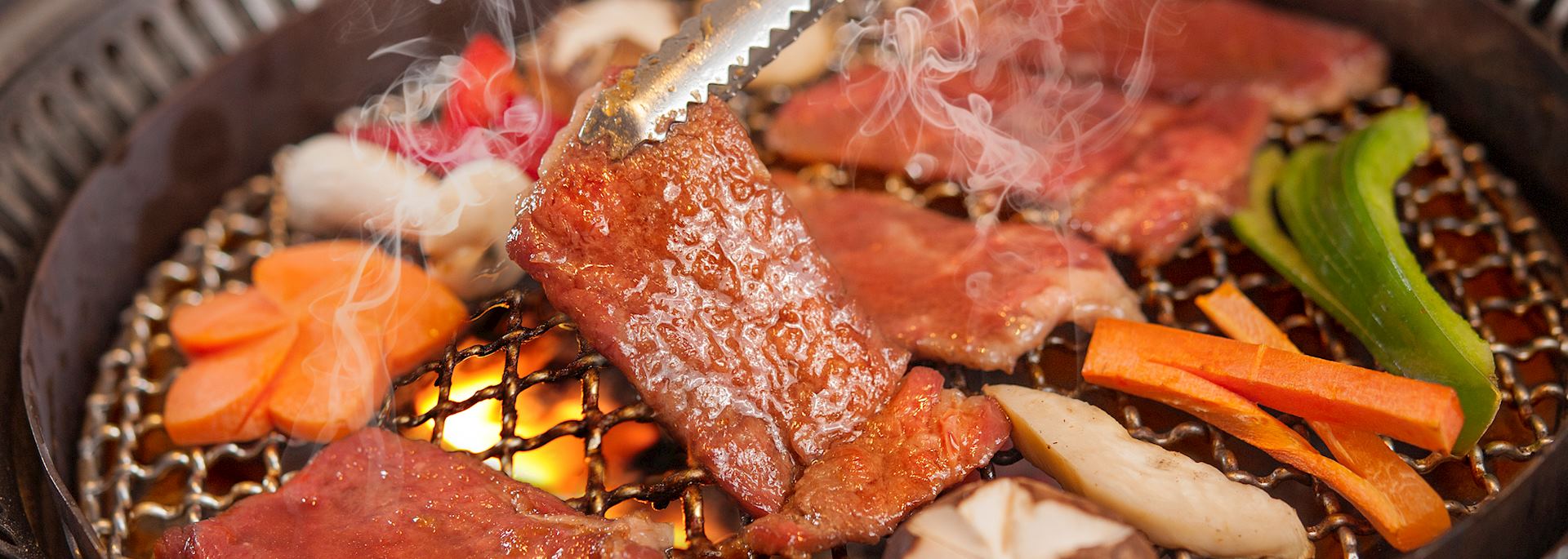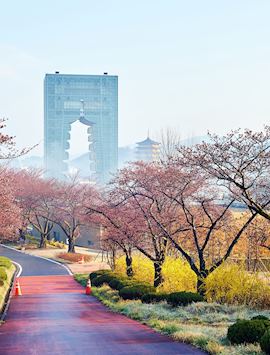South Korea specialist Rebecca
Bold, salty, and often — but not always — spicy, Korean food is complex in every sense of the word. Any cuisine that has more than 100 variations on fermented cabbage isn’t going to be easily encapsulated in an article, so please don’t take this as a complete introduction, despite the title. Instead, you might consider this to be the tiniest tasting platter of banchan, there to whet your appetite only. There’s much more to explore, especially on a trip to South Korea.
Getting started: banchan

I’ll start where almost every Korean meal starts, with banchan, which translates to literally ‘small dishes’ or ‘side dishes’. You’ll receive an array of tiny dishes — anywhere from three to 12 — with just a few bites of various foods. Part condiment, part snack platter, banchan can range from spicy to sharp to pungent.
What’s in each tiny bowl varies hugely, depending on the season, the menu, and the whims of the chef. However, you’ll almost always find at least one variation of kimchi, from the familiar spicy fermented cabbage I mentioned earlier to something less common, like kkakdugi, which is based on cubed radishes. You also might get yellow daikon pickled with onions (danmuji), sticky-sweet fried anchovies (myulchi bokkeum), or fried onion pancakes (pajeon).
Often the food is coated in a neon-red sauce that can look intimidating for the spice-averse. That’s usually gochujang sauce. Made from hot peppers, glutinous rice, fermented soybeans, and salt, it’s one of the most essential components of Korean food. To be honest, it can be eye-wateringly hot — which is how I like it — but sometimes it’s sweet and barely spicy, so sample cautiously but don’t get scared off.
South Korean street food
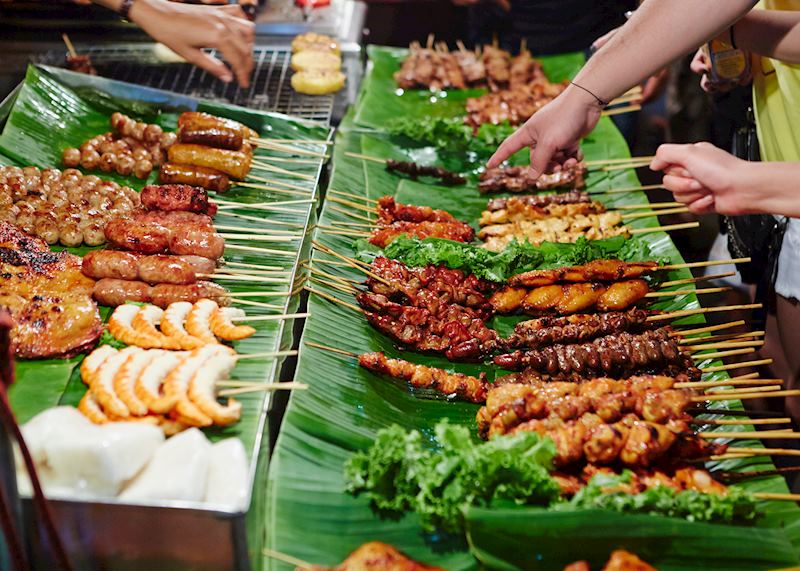
Like many cultures in this part of the world, Korea has a rich tradition of street foods, particularly in the sprawling markets. From tiny carts to kiosks to hole-in-the-wall eateries, you can sample everything from mung bean pancakes to soondae, a light, spicy sausage. The sheer variety can be a bit bewildering at first, even for experienced eaters like me, so I suggest a guided tour in Seoul or Busan to help you get your bearings.
You’ll start in the traditional markets of Insadong and move on to Ikseondong, one of the oldest parts of the city, where you can visit tea houses. I think a highlight is the chance to try octopus that is exceptionally fresh — still wriggling, in fact. Though of course, that’s not to everyone’s taste.
What to drink? Soju and makgeolli
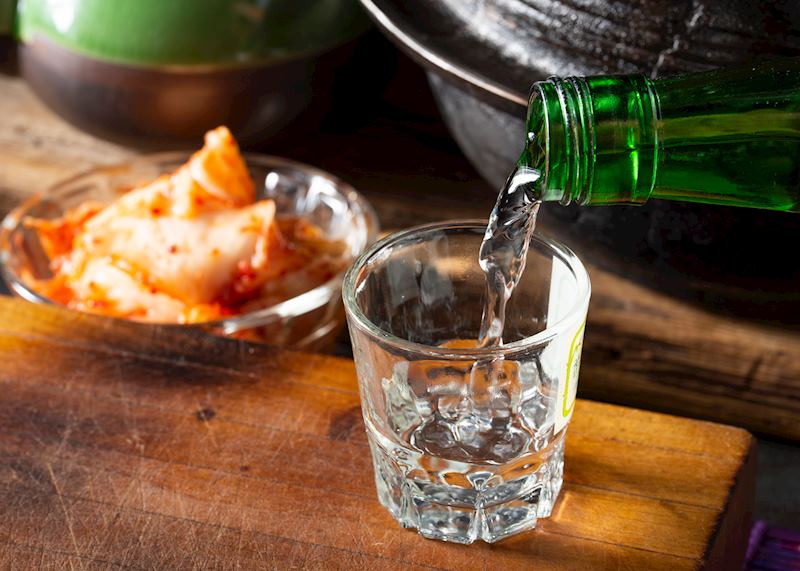
By some reckonings, soju is the most popular form of alcohol in the world. Sometimes called ‘Korean vodka’, it’s a clear spirit made from rice that’s ubiquitous in Korea. You’ll find a selection in almost every restaurant and even in convenience stores. I like the fruity variation; citrus tastes like orange and grapefruit are very popular, though there was a particular craze for chocolate-mint when I went recently, and I fell in love.
Though it’s also made with rice, makgeolli is very different. Mild-tasting, milky white, and lightly fizzy, it’s a slightly thicker drink with less of a kick than soju. Like many yeast-fermented brews, it’s old enough that the drink’s history is a bit muddled, but according to local legend in Busan, it was invented locally, at the Geumjeongsanseong Fortress during the Joseon Dynasty in the 14th or 15th century. If you’d like to learn more, I can arrange a hands-on workshop that will let you try your hand at brewing.
Chimaek for chicken and beer
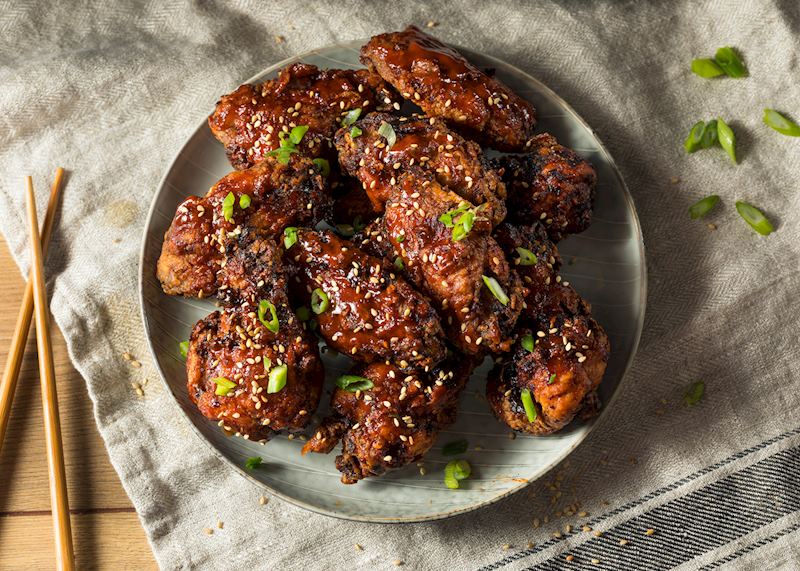
In Korean, the English(ish) word ‘chikin’ is used to mean ‘fried chicken’, a fact that dates back to the late 1970s when Lim’s Chicken pioneered American-style fried chicken in Seoul. Businessman Yu Seok-ho had gone to university in the United States and was inspired by the fried chicken he ate as a student. However, Korean cuisine has been frying chicken in one form or another since the 15th century, and he was drawing upon a rich history and tradition.
Fried chicken, of course, goes beautifully with beer, and in Korea, the two are served together so often that they’ve been christened with a portmanteau name: chimaek, from chicken and maekju (beer). You’ll find innumerable small, casual places serving chimaek, which comes in a wide variety, from sutbul, which is cooked on a charcoal fire, to twice-fried boneless (sunsal) bites.
Eating is always a communal experience in Korea, chimaek even more so than most, and you’ll often see large groups of coworkers or students relaxing together. Because it’s so sociable, sometimes solo diners may find it challenging to find a place to enjoy chimaek by themselves. (I was once turned away from a chimaek with the confused — possibly mistranslated — instruction to come back when I had my friends with me.)
Dinner with friends: Korean barbecue

There’s nowhere more sociable than a Korean barbecue joint. If you’ve never been, this is one of the most quintessential Korean eateries. Each table has its own grill in the middle, where you can grill the assortment of meats and vegetables that you order. Some come plain, while others, like bulgogi, come thinly sliced and marinated in spicy-sweet sauces.
Alongside this, you’ll get an assortment of rice, banchan, and ssam, which are finishing garnishes. Spicy peppers, garlic cloves, grated ginger, and other bold, punchy ingredients make an appearance, adding depth and brightness to the rich, smoky meat.
You’ll also get a selection of lettuce or perilla leaves. Though it’s often translated as ‘sesame leaves’, perilla is actually closer to the mint family, with a clean, green-grass taste. Finally, there’ll be bowls of ssamjang, a dipping sauce that combines the fermented funk of doenjang soybean paste with the fire of gochujang.
Everything at a barbecue place is DIY — you grill your own meat and cut it into easy-to-nibble-sized pieces and then assemble each bite as you see fit. The only rule is that your bite should be just that — one bite. I like to start with a perilla leave, add a thick layer of ssamjang, a dollop of mild rice, and a dash of ginger. Then I top it all with a chunk of galbi, the Korean word for beef short ribs that have been charred to perfection, with a gold-brown crust and curling corners of sizzling fat.
You’ll often see Koreans unwinding after work at barbecue joints, grouped around a table, drinking endless bottles of soju, swapping stories, and assembling their meal one bite at a time. The atmosphere is loudly convivial, with conversations nearly shouted over the blaring K-pop and gales of laughter rolling through the room.
Warming soups & stews
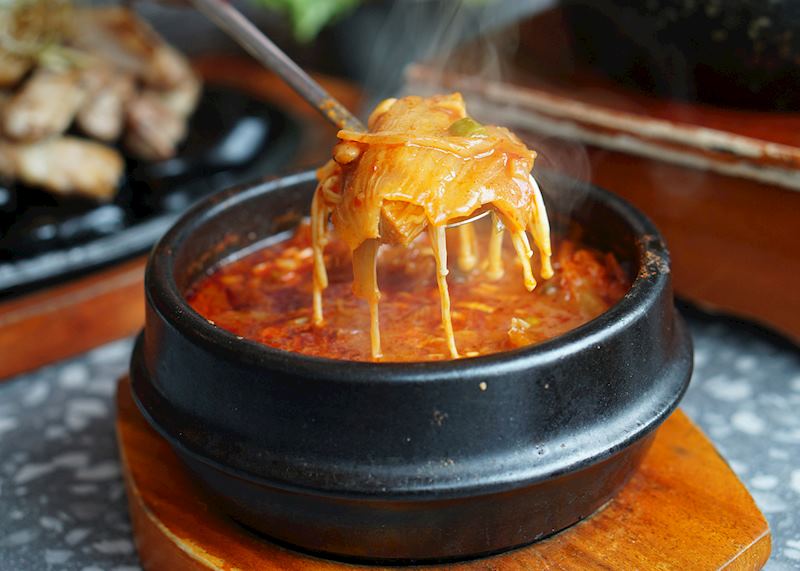
Winters are frigid and unforgiving in Korea and the country’s cuisine features plenty of warming soups and stews, usually with a side of rice. (More on rice in a moment.) Korean food is eaten with chopsticks, called jeosgalag, and with a long spoon, usually made from stainless steel. All Korean food is cut into bite-sized pieces, but especially foods in the soups and stews, where everything is usually braised until it falls apart.
One of the most popular soups is kimchi jjigae, which uses kimchi as the base, but can have almost any ingredient included. It’s often served communally and should be eaten at a piping-hot temperature. Myself, I love sundubu jjigae, a label that covers a variety of stews that all have tofu as the base. The silky soft tofu adds a luscious mouthfeel to the thick, rich broth. It’s a meal that feels warm and filling.
Whatever I order, I like to alternate between bites of the stew and spoonfuls of rice that I carefully lower into the steaming bowl — it’s a tiny thrill to watch the red-tinted broth flood the white grains and the starch helps tame the spice a bit. Others, however, like to just dump the rice in and stir before they start eating. Both methods are entirely authentic.
Start planning your trip to South Korea
Start thinking about your experience. These itineraries are simply suggestions for how you could enjoy some of the same experiences as our specialists. They're just for inspiration, because your trip will be created around your particular tastes.
View All Tours in South Korea
